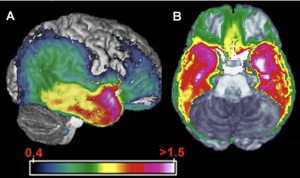Research
Interests
NEURAL SUBSTRATES OF EMOTION AND MOTIVATION
Using functional MRI we can map the brain regions involved in emotion and motivation. Brain regions, such as the amygdala, play an integral role in emotional processing. We have attempted to reveal the situations in which the amygdala becomes more active and the impact of lesions on the amygdala.


NEUROCIRCUITRY AND FUNCTIONS OF THE ORBITOFRONTAL CORTEX
The orbitofrontal cortex lies at the based of the frontal lobe and plays a critical role in personality and psychopathology. I was not a neuroscience major in college. In fact I studied music, film-video and near-eastern studies. Trying to understand what this brain region does was my entry point into the world of neuroscience. Understanding what happens to people when this brain region is damaged and how its functions contribute to psychopathology remain key elements of my lab’s research.

BEHAVIORAL AND PERSONALITY CORRELATES OF INDIVIDUAL DIFFERENCES IN THE DOPAMINE SYSTEM
Multiple aspects of the dopamine system can be measured in humans with Positron Emission Tompograph (PET) imaging, including levels of D2 receptors, dopamine transporters, dopamine synthesis capacity and dopamine release in response to drugs such as amphetamine. We have found that aspects of the dopamine system that regulate dopamine, including autoreceptors and dopamine transporters are related to externalizing traits including impulsivity, novelty-seeking, and antisociality.


THE IMPACT OF AGING ON THE DOPAMINE SYSTEM
D2 dopamine receptors decline steadily with age. Working wit Greg Samanez-Larkin and colleagues at Duke University, we have attempted to understand how these declines impact behavior.

IMPULSIVE AND COMPULSIVE BEHAVIOR
Impulsivity and compulsive behaviors are common problems across different types of psychopathology and even arises in response to certain dopaminergic medicines in Parkinson’s Disease. We have worked to define the neurobiological correlates of these problems.

TRANSDIAGNOSTIC AND NONSPECIFIC DIMENSIONS OF PSYCHOPATHOLOGY
Although psychiatric research and treatment often focuses on specific categorically-defined disorders, the pattern of correlations across symptoms make clear that many mental health problems cut across disorders. Indeed, there is a complex dimensional structure of psychopathology. We have attempted to elucidate the structure of psychopathology, particularly as it relates to a nonspecific general factor of psychopathology. Working with Benjamin Lahey, we provided early evidence for such a nonspecific factor, and have continue to worked to examine whether their are neural correlates of psychopathology that are more related to this general factor as opposed to being related to a specific disorder or narrower dimension of psychopathology.

THE INTERACTION OF EMOTION AND ATTENTION
Emotional stimuli capture our attention. We have attempted to explore precisely how this happens, and where in the brain this prioritization of emotional stimuli occurs.
